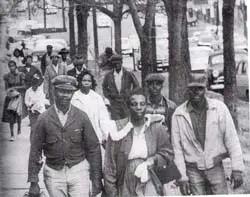Montgomery Bus Boycott
Part of life in the southern states in the 1950’s included specific local and state laws that required that Black Americans sit in the back of the bus as well as a requirement that they give up their seats if a white person needed the seat. When Black American women started objecting to this practice, they were arrested and thrown in jail. It wasn’t until Rosa Parks, a respectable young black woman, refused to give up her seat so that white man could sit, that sparked the life force of the civil rights movement known as the Montgomery Bus Boycott.


During this time, the NAACP (National Association for the Advancement of Colored People) were looking for ways to protest the unfair treatment of Black Americans in the public transportation system. Rosa Parks was a member of the NAACP and on that fateful day in Montgomery, Alabama, Rosa refused to move when the bus driver asked her to.

The arrest of Rosa Parks and her placement in jail was the perfect opportunity for the NAACP to start a protest. They created pamphlets and publications requesting that all of the Black Americans in Montgomery boycott (refuse to support) the bus system. Since a majority of the bus riders were Black Americans, they knew this would hit the system where they would notice it. The NAACP suggested that Black Americans walk, take taxis and even not go to work.

The boycott started on December 5, 1955 and continued for 381 days, which was the amount of time it took for the hearing for Rosa Parks. The Montgomery Bus Boycott was considered to be the first large-scale objection to discrimination practices.


The Black American community elected Martin Luther King, Jr to be the lead representative of a new organization, Montgomery Improvement Association (MIA). As a well-like Baptist minister, King had the ability to attract crowds and followers and yet maintain a message of peaceful demonstration.
The MIA organization presented the City of Montgomery with their requests for equality, with the intention of continuing the boycott until their requests were met. The initial request did not require removal of the segregation laws, only a request that bus drivers use courtesy, the hiring of black bus drivers and seating based on the first-come-first-serve concept. A later law suit against the city in U.S. District Court, sought to have the busing segregation laws removed.

Since the boycott went on so long, Black leaders organized ways to help get those that were supporting the boycott around. They arranged car pools, the African American taxi drivers reduced their fare to ten cents and people walked in groups together. Black American leaders continued to have rallies and meetings to maintain the support.
It took until June 5, 1956, when a Montgomery federal court passed a ruling that it was against the law to racially segregate any seating on buses and that to do so was a violation of the 14th Amendment of the United States Constitution.

The amendment, which was adopted in 1868 after the Civil War, guarantees that all citizens, no matter what their race, have equal rights and protection under federal and state laws. While the city of Montgomery did try to appeal the law at the U.S. Supreme Court, they lost and on December 21, 1956, the boycott ended.




